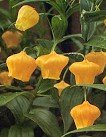 This tender perennial is native to South Africa and Swaziland where it used to be common in grasslands and forest margins but is now rare. It is now grown commercially in Holland, North America, and New Zealand for its unusual flowers. Also known as Christmas bells, golden lily of the valley, and Chinese lantern bulb, it is in the same family as autumn crocus. It should not be confused with Chinese lantern (Physalis alkekengi) which it somewhat resembles in regard to flower shape. Plants are climbing and have slender wiry stems and lance-shaped, ribbed medium green leaves. The pendent yellow to orange flowers are 1¼” long, bell shaped, and appear in late spring and summer on stalks that originate in the leaf axils. The flowers are valued for arrangements and have a vase life of two to three weeks. The fruit is a capsule containing fifty to seventy hard brown seeds; the root system consists of a stoloniferous corm. Plants thrive where winters are warm and summers are cool. In cold climates the tubers can be dug in fall and replanted in spring. The plant contains colchicine which is considered toxic to humans and pets.
This tender perennial is native to South Africa and Swaziland where it used to be common in grasslands and forest margins but is now rare. It is now grown commercially in Holland, North America, and New Zealand for its unusual flowers. Also known as Christmas bells, golden lily of the valley, and Chinese lantern bulb, it is in the same family as autumn crocus. It should not be confused with Chinese lantern (Physalis alkekengi) which it somewhat resembles in regard to flower shape. Plants are climbing and have slender wiry stems and lance-shaped, ribbed medium green leaves. The pendent yellow to orange flowers are 1¼” long, bell shaped, and appear in late spring and summer on stalks that originate in the leaf axils. The flowers are valued for arrangements and have a vase life of two to three weeks. The fruit is a capsule containing fifty to seventy hard brown seeds; the root system consists of a stoloniferous corm. Plants thrive where winters are warm and summers are cool. In cold climates the tubers can be dug in fall and replanted in spring. The plant contains colchicine which is considered toxic to humans and pets.
Type: Tender perennial
Bloom: Bell shaped yellow to orange flowers in late spring to mid summer
Size: 30-36” H
Light: Full sun
Soil: Fertile, sandy loam, medium moist, well-drained; tolerates lean soil
Hardiness: Zones 9-11 but often grown as annual or house plant
Care: Apply fertilizer and water moderately monthy when in growth; water occasionally in winter.
Pests and Diseases: Rot with over watering
Propagation: Seed (difficult; must stratify), division
Companion plants: Blue spikes such as veronica and salvia.
